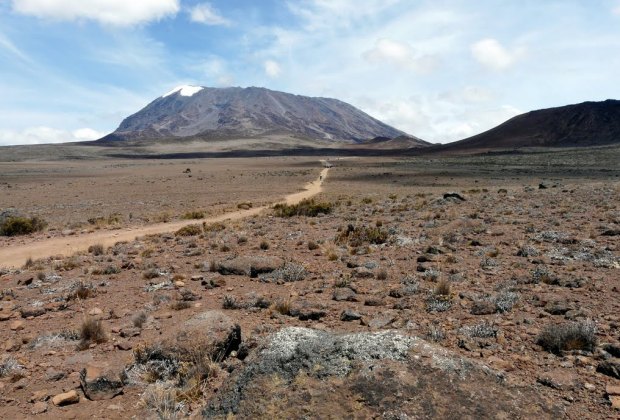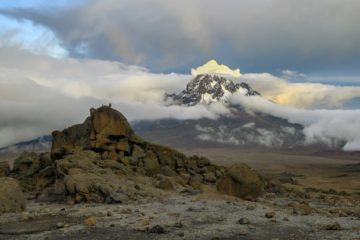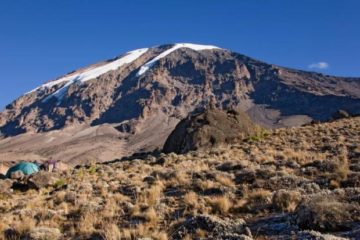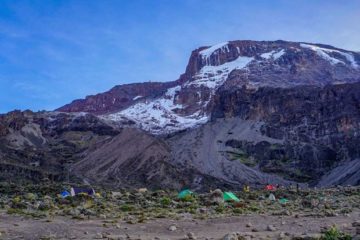The Marangu route, also known as the “Coca-Cola” route, is the oldest, most well-established route on Kilimanjaro. This is the only route that offers sleeping huts in dormitory-style accommodations in lieu of camping. There are 60 bunk beds each at Mandara and Kibo Huts, and 120 bunk beds at Horombo Hut. Guests are supplied with mattresses and pillows, but sleeping bags are still required. The huts have communal dining halls and basic washrooms, ranging from flushing toilets and running water at the lower huts to long drop toilets and buckets of water at Kibo Hut.
Many favor Marangu because it is considered to be the easiest path on the mountain, given its gradual slope and direct path. However, the short time frame of the route makes altitude acclimatization fairly difficult. The route approaches Mount Kilimanjaro from the southeast. Marangu is, unfortunately, less scenic than the other routes because the ascent and descent are along the same path. It is also the most crowded route for that reason.
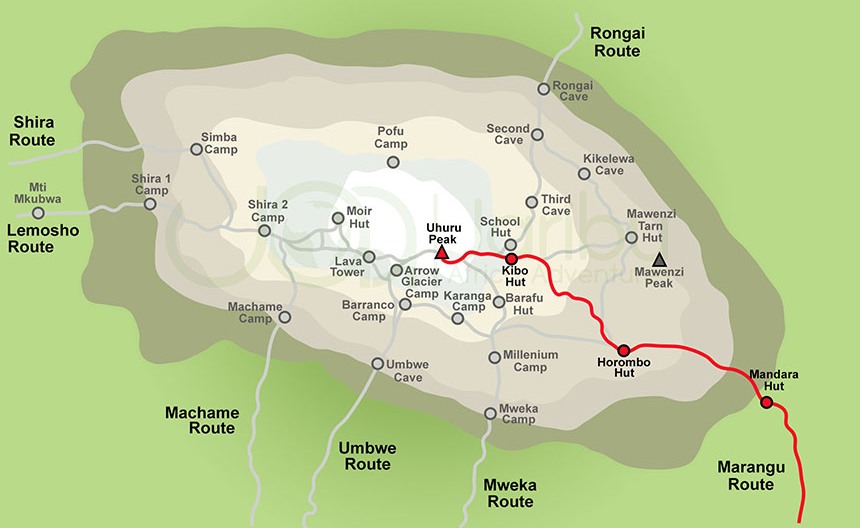
Marangu Gate to Mandara Hut
Elevation (ft): 6,046 ft to 8,858 ft
Distance: 8 km/5 miles
Hiking Time: 4-5 hours
Habitat: Rain Forest
We depart Moshi for Marangu Gate for the necessary formalities before beginning our trek. The hiking trail begins by ascending a beautiful, tropical rain forest. At the upper edge of the forest line, we have the opportunity to see blue monkeys. The trail then widens to expose beautiful hillsides until we reach Mandara Hut.
Mandara Hut to Horombo Hut
Elevation (ft): 8,858 ft to 12,205 ft
Distance: 12 km/7 miles
Hiking Time: 6-8 hours
Habitat: Heath
We start the day continuing through the forest until the trail opens into high moorland. We may get our first views of Kibo and Mawenzi peaks – two of the three volcanic peaks that make up the summit of Kilimanjaro.
Horombo Hut to Mawenzi Ridge
Elevation (ft): 12,205 ft to 14,400 ft
Distance: 5 km/3 miles
Hiking Time: 2-3 hours
Habitat: Heath
Mawenzi Ridge to Horombo Hut
Elevation (ft): 14,400 ft to 12,205
Distance: 5 km/3 miles
Hiking Time: 1-2 hours
Habitat: Heath
This is an extra day meant for acclimatization and can be spent the day hiking on Mawenzi Ridge. The unique landscape offers motivating views of Kibo and Mawenzi. After spending a few moments exploring the area we head back to Horombo Hut.
Horombo Hut to Kibo Hut
Elevation (ft): 12,205 ft to 15,430 ft
Distance: 10 km/6 miles
Hiking Time: 6-8 hours
Habitat: Alpine Desert
We climb gradually, then cross the lunar desert of the “Saddle” between Mawenzi and Kibo. Our camp, Kibo Hut, sits at the bottom of the Kibo crater wall. Once here we rest, enjoy an early dinner to prepare for the summit day.
Kibo Hut to Uhuru Peak
Elevation (ft): 15,430 ft to 19,341 ft
Distance: 6 km/4 miles
Hiking Time: 6-8 hours
Habitat: Arctic
Uhuru Peak to Horombo Hut
Elevation (ft): 19,341 ft to 12,250 ft
Distance: 16 km/10 miles
Hiking Time: 4-5 hours
Habitat: Heath
Very early in the morning (around midnight), we begin our push to the summit. This is the most mentally and physically challenging portion of the trek. The wind and cold at this elevation and time of day can be extreme. We ascend in the darkness for several hours while taking frequent, but short, breaks. At Gilman’s point (18,600 ft), you will be rewarded with the most magnificent sunrise you are ever likely to see coming over Mawenzi Peak. Finally, we arrive at Uhuru Peak- the highest point on Mount Kilimanjaro and the continent of Africa.
After spending a few moments taking in the plains of Africa and your accomplishment, we descend to Horombo Hut. Later in the evening, we enjoy our last dinner on the mountain and a well-earned sleep.
Horombo Hut to Marangu Gate
Elevation (ft): 12,205 ft to 6,046 ft
Distance: 20 km/12 miles
Hiking Time: 5-7 hours
Habitat: Rain Forest
On our last day, we have a long trek mostly downhill through the tropical rainforest. Once at the park headquarters at Marangu gate, we collect our summit certificates. A vehicle will meet us here and drive us back to the hotel in Moshi.
| INCLUDES | NOT INCLUDED |
|---|---|
Safety Equipment:
MOUNTAIN CREW:
MOUNTAIN ENTRY FEES:
CAMPING EQUIPMENT AND OTHER GEARS:
MOUNTAIN MEALS
TRANSPORT
|
|


